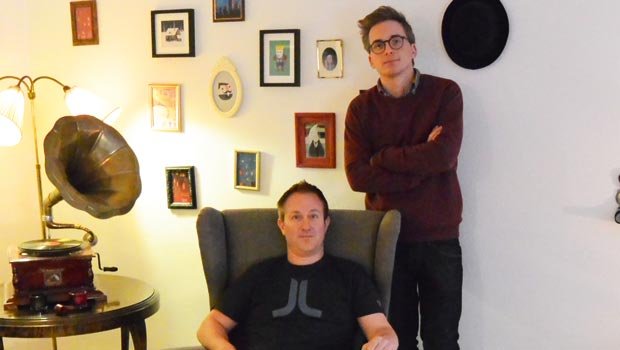Studio Profile: Simogo

Whenever Simogo attends a game conference, Simon Flesser will give his job title as “a little bit of everything”, while Magnus ‘Gordon’ Gardebäck is referred to as “Strongman”. It’s a typically unorthodox response for a two-man studio that wilfully defies pigeonholing, its output so far taking in whimsical action games and text-based thrillers, rhythmic heists and wintry horrors. The ability to wrong-foot an audience is clearly one of the secrets of its success. “It’s always about wanting to make things that feel exciting for us to make – things that will surprise people as well as ourselves,” Flesser says. In a risk-averse market, this desire to buck convention is a rare quality indeed.
Based in Malmö, Sweden, this odd-couple pairing first met at now-defunct studio Southend Interactive, the first game-related job for both. Simogo might have found its home on iOS, but it was another portable device that encouraged Flesser, a former animator on commercial projects (“Lego, Lego and more Lego”) to move into games. The wild, experimental spirit of early DS titles such as Yoshi Touch & Go, Pac-Pix and Osu! Tatakae! Ouendan inspired Flesser to pursue his own interactive concepts. Gardebäck’s background, meanwhile, was in security systems.
Before leaving Southend, the two worked on XBLA puzzler Ilomilo, with Gardebäck as a programmer and Flesser responsible for the game’s art. Though the game was well liked, the process only made Flesser more determined to leave to produce something that he could call his own. “Part of it was seeing that it was possible for me to make loads of content by myself, but I think [it was] also being creatively very tired after making it for so long, and wanting to make smaller things. And also wanting to do things differently, without all the politics that comes with the traditional developer-publisher model.”
The two may not have left Southend with a concrete idea for their debut, but the newly formed Simogo already knew which format it would be working on. At the time, iOS was a burgeoning platform for experimental new outfits, and Apple’s open-door approach made self-publishing inviting. “The general idea was that we thought it would be great if we could make at least two games a year,” Flesser recalls. “When there was only the [iPhone] 3GS, it was really exciting – all those early classics like Space Invaders Infinity Gene, Eliss, Drop7.”
The breezy arcade-like pleasures of Kosmo Spin got Simogo’s career off to a fine, if inauspicious start, though Flesser notes that some of his friends still think it’s his best game. “It didn’t sell very well,” he admits. “Not catastrophically, but around what you could expect from a very small game from a completely unknown studio.” This applied a certain pressure to get the next project done quickly, and indeed, having only finished up its work on Kosmo Spin in November 2010, Simogo had a control prototype for its follow-up in place by Christmas that year.
Bumpy Road was released in May 2011, and was far more successful: comments from high-profile developers and glowing previews generated a buzz that earned it a coveted Game Of The Week spot on the App Store. Flesser puts much of that down to its audiovisual appeal, citing Yann Tiersen’s Amélie soundtrack and Les Triplettes De Belleville as inspiration. “I often get accused of being a total Francophile, and I think that shines through in Bumpy Road,” he says.
Mac and PC ports followed, but before those came the launch of Beat Sneak Bandit on iOS, its combination of stealth puzzles and rhythm-action earning Simogo Best Mobile Game at the 2012 Independent Games Festival. Then came the pair’s first real setback: a concept produced for a high-profile publisher on another format earned a favourable response at first, but with design documents and a prototype in place, the project was unexpectedly cancelled. In its stead, a short story from author Jonas Tarestad – a childhood friend of Flesser – was steadily remoulded into an unsettling firstperson psychological horror story.
Sign up to the GamesRadar+ Newsletter
Weekly digests, tales from the communities you love, and more
Released a full year after Beat Sneak Bandit, Year Walk marked the beginning of a new chapter in Simogo’s career, with a clear shift towards more narrative-led experiences. It was also the first Simogo game to require external assistance. “The seed of it was from Jonas with his script, so working together with outside people felt natural,” Flesser explains.
The studio was continuing to confound expectations with every release, but Flesser insists that it wasn’t necessarily a conscious decision. “To be honest with you, we don’t really have a great plan, so it’s never, ‘OK let’s do something different this time.’ It’s mostly about wanting to make what feels exciting to us, and that happens to [involve] making something that is different each time. Do we have a house style? Well, yes and no. I think you have to have some kind of continuity, but when you are such a small studio that tends to come naturally, really.”
Yet Simogo’s next game was a direct reaction to Year Walk, though this wasn’t simply about a desire to explore conceptually and thematically new territory. After all, Flesser and Gardebäck had left a larger developer so they could make shorter games, yet had just spent over ten months on a single project. After the game had launched, they went over Year Walk’s development process to see how they could make their next project less of a struggle.

“One of the earliest things we did for Device 6 was deciding to divide it up into confined chapters instead of it taking part in one large world,” Flesser says. “We’d treat every chapter as a separate project, and be completely done with one chapter before moving on to the next. That was a very enjoyable way of making a game, because we were being constantly gratified with the results.” With each chapter taking just three or four weeks to make, it was a rewarding process for Simogo – “like making six little projects in one,” Flesser tells us – with the story’s interstitial tests acting as refreshing palate cleansers for both player and game-maker.
That sense of fun comes across in the finished game: Device 6 tells a dark story, but it’s light on its feet, as mischievous as it is meticulous. Three BAFTA nominations, a clutch of game of the year awards, and another gong from the IGF for Excellence In Audio followed, the latter in no small part thanks to the soundtrack created by another former Southend Interactive player, Daniel Olsén, who Flesser had first called upon for Year Walk. By this time, others had been welcomed into the extended Simogo family – indeed, that term was coined by singer-songwriter Jonathan Eng, whose contribution to Device 6 was an upbeat earworm few could forget.
If there’s any connective tissue between the two – and the studio’s sixth game, The Sailor’s Dream – it’s Simogo’s desire to experiment with unusual structures, input methods and narrative delivery systems. “Like how form and story becomes one?” Flesser asks. “Yes! I love exploring that. It’s interesting that more people don’t try that. I’m kind of obsessed with it. If we have an idea for an interaction or whatever, I’m always asking, ‘OK, but what is this supposed to mean within the game? Is it a symbol? Why do we do this?’ Like in The Sailor’s Dream, when you approach islands, you get these little pages, which are pages of the girl’s sketchbook. So that kind of thinking makes stuff [harmonise] really nicely. I mean, liking something, or ‘because it’s fun’ are good reasons for anything, but if that is the only reason for all of your components, I feel you’re likely to get a lot of nice things that aren’t really strung together by any logic.”
And yet for once the critical response to a Simogo game was sharply divisive. Specialist publications were generally underwhelmed, while a handful of mainstream, non-gaming sites were smitten. Even Apple was colder on it than usual. After Flesser took to Twitter to bemoan iOS 8 accessibility issues, plus the time and expense of developing for new screen sizes for iPhone 6, he was further upset by the platform holder’s choice to highlight two other apps released that week ahead of The Sailor’s Dream. Having talked of his delight in “weird things” like Device 6 and Year Walk earning enough money to support Simogo, there’s the hint its latest app hasn’t broken even. “It is a problem,” Flesser tells us. “It has been hard to communicate [what it is], and maybe we made a mistake by categorising it under games. We might change that and do a mini relaunch. But we’re still talking about that.”
In the meantime, Simogo has released The Sensational December Machine, a free short story on PC. It’s a brief but typically well-crafted parable about our obsession with technology and the demands we place upon it, as well as our desire to categorise, and how that’s problematic for creators seeking to challenge established ideas. A gift to fans, it also sees Flesser finding a form of catharsis after The Sailor’s Dream.
Perhaps, we suggest to Flesser, the critical response to The Sailor’s Dream might be useful in the long run, in that a developer on a previously unbroken hot streak might now feel a little less pressure to outdo itself. Could this be the start of a new chapter in the Simogo story? “I think it’s the next chapter in the sense that we don’t feel we have to be so restrained in what’s coming next – it doesn’t always have to be the next big thing. And I think The Sensational December Machine is the first step in that direction.”
Further hints for future projects are dropped: “We have one prototype of a game that we really like, which to me feels a bit like a mix of our old and new style.” Flesser adds that Simogo might even explore noninteractive ideas, perhaps spinning off from the worlds, characters and concepts featured in its previous games.
Despite Simogo’s achievements, Flesser is keen to remind us that success is relative. “People tend to assume that just because they see a developer mentioned in a lot of places, they do huge numbers with their games. Few people realise that a lot of games from small studios struggle to sell [more than] 20,000 copies.”
But it’s clear the pair that once gave a GDC talk called Success Through Not Doing What Everyone Tells You To Do isn’t really striving for mainstream acceptance. “We’re probably both happy about where we are, but also ambivalent about it. We push ourselves to create new things because we know we need to struggle, but also it’s tiring to always be remotely successful.” For now, Flesser and Gardebäck are happy to shun the limelight and allow Simogo’s games to speak for themselves. Luckily, they have plenty to say.
Edge magazine was launched in 1993 with a mission to dig deep into the inner workings of the international videogame industry, quickly building a reputation for next-level analysis, features, interviews and reviews that holds fast nearly 30 years on.



